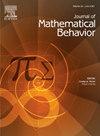Quantitative civic literacies: “Let’s talk about election 2020” and youth use of numbers in digital civic media
IF 1.7
Q3 EDUCATION & EDUCATIONAL RESEARCH
引用次数: 0
Abstract
Amid global turmoil, the mathematical demands of civic life and the civic demands of mathematics education are greater than ever. International goals of mathematics education include preparation for civic life. Curricula focused on receptive analytic activities, however, positions youth as underdeveloped civic actors needing preparation for responsible future participation rather than treating them as civic actors today. To better understand how youth use mathematics in their civic participation today, we conceptualize quantitative civic literacies as the practices of reinscribing quantitative information into civic participation. We investigate quantitative civic literacies in youth digital civic media about racial justice, the COVID-19 pandemic, and the climate crisis, drawing data from a US-based, public radio-hosted, digital media platform called Let’s Talk about Election 2020. Findings identified six quantitative civic literacies engaged by youth; youth used quantitative forms including counts and locations, relationship and change, and uncertainty in making civic arguments to (1) communicate the magnitude of an issue, (2) situate an issue in space or time, (3) reason about causation or propose a theory of change, (4) provide specificity through narrative detail, (5) make claims about identity, and (6) reveal injustice. Beyond providing logical argumentation and legitimacy, numbers were used by youth to activate empathy and mobilize ethical calls in attempts to move others to action. With these insights, we provide inroads for a mathematics education for civic life that builds on a more expansive understanding of the rhetorical potential of numbers and of youth as civic actors to nurture youth quantitative civic literacies.
定量公民素养:数字公民媒体中的 "让我们来谈谈 2020 年大选 "和青少年对数字的使用
在全球动荡中,公民生活对数学的需求和公民对数学教育的需求比以往任何时候都要大。数学教育的国际目标包括为公民生活做准备。然而,课程侧重于接受性分析活动,将青年定位为欠发达的公民行为体,需要为负责任的未来参与做准备,而不是将他们视为今天的公民行为体。为了更好地理解今天的年轻人如何在公民参与中使用数学,我们将定量公民素养定义为将定量信息重新写入公民参与的实践。我们调查了青年数字公民媒体中关于种族正义、COVID-19大流行和气候危机的定量公民素养,并从美国公共广播主持的数字媒体平台“Let 's Talk about Election 2020”中获取数据。调查结果确定了青年参与的六种定量公民素养;青年在进行公民辩论时使用数量形式,包括数量和位置,关系和变化,以及不确定性,以(1)传达问题的严重性,(2)将问题置于空间或时间中,(3)推理因果关系或提出变化理论,(4)通过叙事细节提供特殊性,(5)对身份提出要求,(6)揭示不公正。除了提供合乎逻辑的论证和合法性之外,年轻人还用数字来激发同理心,动员道德呼吁,试图推动他人采取行动。有了这些见解,我们为公民生活的数学教育提供了进展,这种教育建立在对数字和青年作为公民行动者的修辞潜力的更广泛理解的基础上,以培养青年的定量公民素养。
本文章由计算机程序翻译,如有差异,请以英文原文为准。
求助全文
约1分钟内获得全文
求助全文
来源期刊

Journal of Mathematical Behavior
EDUCATION & EDUCATIONAL RESEARCH-
CiteScore
2.70
自引率
17.60%
发文量
69
期刊介绍:
The Journal of Mathematical Behavior solicits original research on the learning and teaching of mathematics. We are interested especially in basic research, research that aims to clarify, in detail and depth, how mathematical ideas develop in learners. Over three decades, our experience confirms a founding premise of this journal: that mathematical thinking, hence mathematics learning as a social enterprise, is special. It is special because mathematics is special, both logically and psychologically. Logically, through the way that mathematical ideas and methods have been built, refined and organized for centuries across a range of cultures; and psychologically, through the variety of ways people today, in many walks of life, make sense of mathematics, develop it, make it their own.
 求助内容:
求助内容: 应助结果提醒方式:
应助结果提醒方式:


